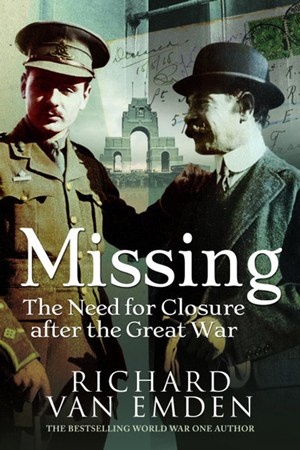MISSING - THE NEED FOR CLOSURE AFTER THE GREAT WAR
Author: Richard van Emden
Publisher: Pen & Sword Military, 312 pages, 64 b/w photos
Published: 6th April 2020
ISBN: 9781526761002
Price: £20.00
How long would you look for a missing son, even if you knew he was dead? How long could you justify such a search? Two years? Five years? A lifetime? Angela’ s son, Francis Mond, a Royal Air Force pilot, had been shot down and killed, but where was his body?
Richard van Emden has a wonderful engaging writing style, and uses it beautifully here to blend in the gripping story of Angela’s search for her son’s grave with how the nation was coping with the impact of loss in the postwar years. ‘Missing’ is just one vignette in what would have been a whole gallery of similar stories. Thanks to the author and Mond’s family this story can be shared.
This moving story of Francis begins his wartime story in 1914 when he receives the transfer he wants into the fledgling Royal Flying Corps. After little more than three hours of dual control Francis goes solo and gains the coveted wings. By June 1915 he was operational flying in France with 16 Squadron, but 90 hours’ flying experience his time in the air was running out and on 6 September 1915 a mechanical problem with his aircraft caused it to crash, Francis and his observer, badly injured, were very lucky to survive. Francis was also suffering from the strains of war with PTSD or shell-shock as it was referred to then, and only returned to flying voluntarily in 1918 at the time of the German spring offensive. It was in May 1918 that he was over the Somme with 57th Squadron and killed. This is where the story almost begins as we follow Angela’s anguish in the search for her son’s grave, the burial place for which had become lost in mayhem of war. Like many mothers and fathers, Angela is not willing to accept that her son’s grave is missing and with grieving determination never gives up the search.
As well as being a story about this search, it is also one about the need for closure for many other family members who lost a loved once during this conflict. It charts the story of the modern day Commonwealth War Graves Commission and the monumental task they had in those immediate post war years. The story of recovering and identifying the dead is fascinating and the challenges that those early battlefield clearers and graves registration units had. How to remember the dead was yet another task in a post-war Britain that was in financial ruin after five years of global conflict, and a conflict that did not end with the cease-fire on 11 November 1918. There was enormous pressure to clear the battlefields before pilgrimages and battlefield tourists would descend on France, Flanders and maybe some of those a little out of reach such as Gallipoli, Salonika, Mesopotamia etc. The huge task paired with pressure to bring clearance to a close has left some areas not fully cleared which today is evident in the amount of bodies, usually just partial skeletal remains, across the old battlefield lines. Mistakes were also made mis-identifying the dead, like the case of Francis, or bodies that could have been identified being ignored, be it by a sloppy labourer, a local landowner or an administrative error. This is but expected, but missing or not, the memorials and cemeteries of stone across the Western Front and rest of the world illustrate to the visitor clearly that no one is forgotten or missing. In the words of Field Marshal Lord Plummer who told the assembled families of the fallen at the opening of the Menin Gate in Ypres, “He is not missing. He is here.”
This is an excellent book, one of the best read this year. Thoroughly recommended.


